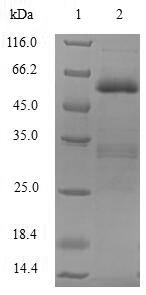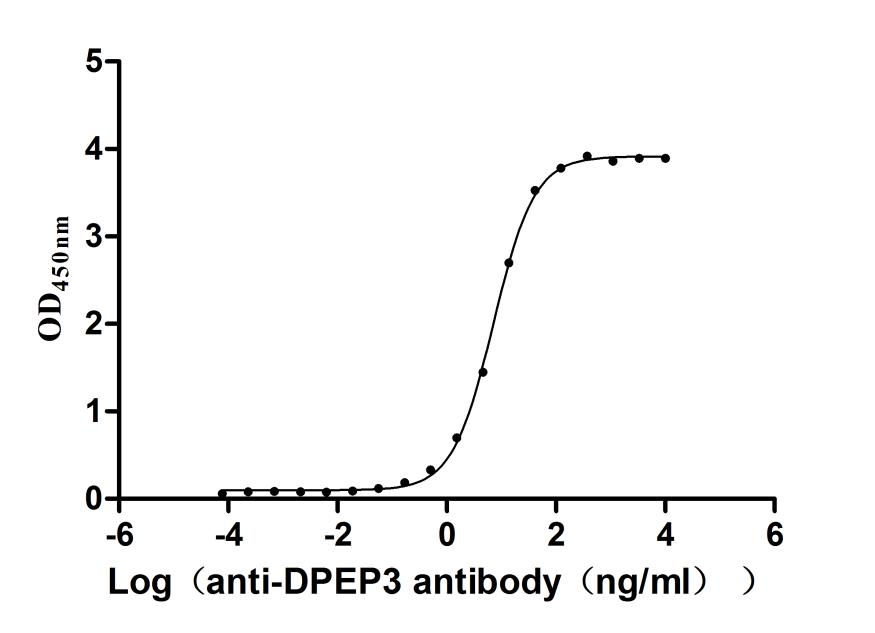Recombinant Human E3 ubiquitin-protein ligase SIAH1 (SIAH1)
In Stock-
中文名稱:人SIAH1重組蛋白
-
貨號(hào):CSB-EP818230HU
-
規(guī)格:¥1344
-
圖片:
-
其他:
產(chǎn)品詳情
-
純度:Greater than 90% as determined by SDS-PAGE.
-
基因名:
-
Uniprot No.:
-
別名:E3 ubiquitin-protein ligase SIAH1; FLJ08065; hSIAH1; HUMSIAH; Seven in absentia homolog 1 (Drosophila); Seven in absentia homolog 1; Siah 1; Siah 1a; Siah E3 ubiquitin protein ligase 1; Siah-1; Siah-1a; Siah1; SIAH1_HUMAN; SIAH1A; Ubiquitin ligase SIAH1
-
種屬:Homo sapiens (Human)
-
蛋白長(zhǎng)度:Full Length of Isoform 2
-
來(lái)源:E.coli
-
分子量:61.6kDa
-
表達(dá)區(qū)域:1-313aa
-
氨基酸序列MTGKATPPSLYSWRGVLFTCLPAARTRKRKEMSRQTATALPTGTSKCPPSQRVPALTGTTASNNDLASLFECPVCFDYVLPPILQCQSGHLVCSNCRPKLTCCPTCRGPLGSIRNLAMEKVANSVLFPCKYASSGCEITLPHTEKADHEELCEFRPYSCPCPGASCKWQGSLDAVMPHLMHQHKSITTLQGEDIVFLATDINLPGAVDWVMMQSCFGFHFMLVLEKQEKYDGHQQFFAIVQLIGTRKQAENFAYRLELNGHRRRLTWEATPRSIHEGIATAIMNSDCLVFDTSIAQLFAENGNLGINVTISMC
Note: The complete sequence including tag sequence, target protein sequence and linker sequence could be provided upon request. -
蛋白標(biāo)簽:N-terminal GST-tagged
-
產(chǎn)品提供形式:Liquid or Lyophilized powder
Note: We will preferentially ship the format that we have in stock, however, if you have any special requirement for the format, please remark your requirement when placing the order, we will prepare according to your demand. -
緩沖液:If the delivery form is liquid, the default storage buffer is Tris/PBS-based buffer, 5%-50% glycerol.
Note: If you have any special requirement for the glycerol content, please remark when you place the order.
If the delivery form is lyophilized powder, the buffer before lyophilization is Tris/PBS-based buffer, 6% Trehalose. -
儲(chǔ)存條件:Store at -20°C/-80°C upon receipt, aliquoting is necessary for mutiple use. Avoid repeated freeze-thaw cycles.
-
保質(zhì)期:The shelf life is related to many factors, storage state, buffer ingredients, storage temperature and the stability of the protein itself.
Generally, the shelf life of liquid form is 6 months at -20°C/-80°C. The shelf life of lyophilized form is 12 months at -20°C/-80°C. -
貨期:3-7 business days
-
注意事項(xiàng):Repeated freezing and thawing is not recommended. Store working aliquots at 4°C for up to one week.
-
Datasheet & COA:Please contact us to get it.
相關(guān)產(chǎn)品
靶點(diǎn)詳情
-
功能:E3 ubiquitin-protein ligase that mediates ubiquitination and subsequent proteasomal degradation of target proteins. E3 ubiquitin ligases accept ubiquitin from an E2 ubiquitin-conjugating enzyme in the form of a thioester and then directly transfers the ubiquitin to targeted substrates. Mediates E3 ubiquitin ligase activity either through direct binding to substrates or by functioning as the essential RING domain subunit of larger E3 complexes. Triggers the ubiquitin-mediated degradation of many substrates, including proteins involved in transcription regulation (ELL2, MYB, POU2AF1, PML and RBBP8), a cell surface receptor (DCC), the cell-surface receptor-type tyrosine kinase FLT3, the cytoplasmic signal transduction molecules (KLF10/TIEG1 and NUMB), an antiapoptotic protein (BAG1), a microtubule motor protein (KIF22), a protein involved in synaptic vesicle function in neurons (SYP), a structural protein (CTNNB1) and SNCAIP. Confers constitutive instability to HIPK2 through proteasomal degradation. It is thereby involved in many cellular processes such as apoptosis, tumor suppression, cell cycle, axon guidance, transcription regulation, spermatogenesis and TNF-alpha signaling. Has some overlapping function with SIAH2. Induces apoptosis in cooperation with PEG3. Upon nitric oxid (NO) generation that follows apoptotic stimulation, interacts with S-nitrosylated GAPDH, mediating the translocation of GAPDH to the nucleus. GAPDH acts as a stabilizer of SIAH1, facilitating the degradation of nuclear proteins. Mediates ubiquitination and degradation of EGLN2 and EGLN3 in response to the unfolded protein response (UPR), leading to their degradation and subsequent stabilization of ATF4.
-
基因功能參考文獻(xiàn):
- Depletion of KDM3A coincided with the loss of SIAH1 induction and the accumulation of dimethylated H3K9 surrounding the SIAH1 promoter. Interestingly, KDM3A expression was also up-regulated by nutritional stress in a HIF-1alpha dependent manner. PMID: 28843785
- The crystallographic models provide structural insights into the substrate binding of the SIAH family E3 ubiquitin ligases that are critically involved in regulating cancer-related pathways. PMID: 27776223
- Results showed that SIAH1 and PTP4A1 expression was regulated by mir-944 in breast cancer cells. miR-944 binds directly the 3 UTR of their promotor region. PMID: 27377268
- Study identified SIAH1/2 (SIAH) as the E3 ligase mediating Wnt-induced Axin degradation. SIAH proteins promote the ubiquitination and proteasomal degradation of Axin through interacting with a VxP motif in the GSK3-binding domain of Axin, and this function of SIAH is counteracted by GSK3 binding to Axin. PMID: 28546513
- results suggest that CacyBP/SIP is involved in regulation of the Hsp90 chaperone machinery PMID: 27249023
- PINK1 disease mutants failed to recruit synphilin-1 and did not activate mitophagy, indicating that PINK1-synphilin-1-SIAH-1 represents a new parkin-independent mitophagy pathway. Drugs that activate this pathway will provide a novel strategy to promote the clearance of damaged mitochondria in Parkinson's disease. PMID: 27334109
- Results suggest that activated STAT3 regulates active beta-catenin protein levels via stabilization of SIAH-1 and the subsequent ubiquitin-dependent proteasomal degradation of beta-catenin in HEK293T cells. PMID: 27871173
- Siah-1 expression was observed in 41.4% of oral squamous cell carcinoma. Siah-1 was expressed in the cytoplasm and cell membranes, and partially in the nucleus . PMID: 27616748
- SIAH1 is associated with a tumor promoting role in breast cancer. PMID: 26654769
- In neuroblastoma cells, siRNA silencing of SIAH1 promoted cellular proliferation and suppressed apoptosis. Protein and mRNA expression of alpha-synuclein, LC3-II and p53 decreased after SIAH1 knockdown. E1 protein and mRNA levels increased after SIAH1 siRNA. PMID: 26722480
- Results demonstrated that miR-107 directly down-regulated SIAH1 expression in human breast cancer cells. An inverse correlation between the expression of miR-107 and SIAH1 was found in human breast cancer tissues and cell lines. PMID: 25851994
- Similar to TAp73, DNp73 is stabilized by hypoxia in a HIF-1a-dependent manner, which otherwise is degraded by Siah1. PMID: 26267146
- findings demonstrate that dissociation of the GAPDH/Siah1 pro-apoptotic complex can block high glucose-induced pericyte apoptosis, widely considered a hallmark feature of DR PMID: 26438826
- Data indicate that ubiquitin ligase Siah as a regulator of to Mesenchymal Transition (EMT) by controlling the abundance of the key transcription factor Zeb1, while Siah itself is subject to regulation by EMT-inducing factors. PMID: 25528765
- miRNA network regulates SIAH1 in in colorectal metastasis tissues. PMID: 26069251
- CDK2 up-regulates the protein level of KLF10 through reducing its association with SIAH1, a KLF10 E3-ubiqutin ligase involved in proteasomal degradation. PMID: 25728284
- molecular basis of Siah1 and Siah2 E3 ubiquitin ligase substrate specificity PMID: 25202994
- Siah1 is a substrate of ASK1 for activation of the GAPDH-Siah1 oxidative stress signaling cascade. PMID: 25391652
- SIAH-1 plays an essential role in beta-catenin degradation in HCT116 CRC cells and that CSN5 affects beta-catenin target gene expression in these cells. PMID: 24882689
- miR-135a/SIAH1/beta-catenin signaling is important in the transformation and progression of cervical carcinoma. PMID: 24503442
- The spatial orientation of one zinc-finger subdomain in Siah1 ubiquitin ligase differs with respect to the rest of the dimeric protein. PMID: 24316825
- the molecular mechanisms modulating ACK1 PMID: 23208506
- USP19 interacts with the ubiquitin ligases SIAH1 and SIAH2, which promote USP19 ubiquitylation and degradation by the proteasome. PMID: 23500468
- High expression of seven-in-absentia homologue 1 is associated with nasopharyngeal carcinoma. PMID: 23228635
- Calmodulin-regulated Siah-1A binding to mGluR5 dynamically regulates mGluR5 trafficking PMID: 23152621
- Siah1 is the E3 ubiquitin ligase for ELL2 polyubiquitination and proteasomal degradation. PMID: 22483617
- In sharp contrast to SIAH1/SIAH2 and UBCH8, TRIAD1 binding to PML-RARalpha has no effect on its turnover. PMID: 22037423
- Taken together, our data suggest EFF1D functions as a novel negative regulator of SIAH-1. PMID: 21633900
- Siah-1 may play an important role in ubiquitin-dependent degradation of hepatitis B virus X protein and may be involved in suppressing the progression of hepatocellular carcinoma (HCC). PMID: 21878328
- infection of SIAH-1 knockdown cells with HSV, higher levels of ICP0 were produced, ICP0 was less ubiquitinated, and the half-life of this multifunctional viral regulatory protein was increased PMID: 21632771
- results suggest that hypoxia downregulates beta-catenin by increasing Siah-1 expression in a p53-dependent manner PMID: 21466614
- ARTS interacts with the E3 ligase Siah-1 (seven in absentia homolog 1) to induce ubiquitination and degradation of XIAP. PMID: 21185211
- Herp temporarily bound to E3 ligase SIAH1a during proteolytic stress but not during ER stress. PMID: 20604806
- Overexpression of Siah1L and Siah1 is associated with radiosensitivity of breast cancer. PMID: 20682032
- these results propose a novel role of SIAH-1 in regulating the expression level of HPH2 through the ubiquitin-proteasome pathway. PMID: 20471960
- Siah1 is a bona fide E2F1 target gene, which at least partly, mediates the suppression of beta-catenin/TCF signalling pathway PMID: 20187294
- Immunofluorescence microscopy shows that the intracellular distribution of SIAH-1 and Kid/KIF22 appears to be modified in human tumor tissues compared to normal controls PMID: 20144232
- increase of the function of SIAH1 to upregulate the expression of Bim may play an important role in the progression of breast cancer PMID: 20082325
- Direct ubiquitination of beta-catenin by Siah-1 and regulation by the exchange factor TBL1. PMID: 20181957
- JNK and ERK signaling pathways may play an important role in the SIAH1-dependent biological behavior of breast cancer. PMID: 19775288
- siah-1 Protein is necessary for high glucose-induced glyceraldehyde-3-phosphate dehydrogenase nuclear accumulation and cell death in Muller PMID: 19940145
- Siah proteins function as E3 ubiquitin-protein ligases PMID: 11786535
- The Siah-1 gene promoter was cloned and the basic structure of the Siah-1 gene was determined. PMID: 11852084
- genetic regulation in tumor reversion PMID: 12399545
- structural analysis and interaction with Siah-interacting protein PMID: 12421809
- SIAH1 has been identified as a putative tumor suppressor gene for human hepatocellular carcinomas, with a correlation between its suppressed expression and tumor size and differentiation. PMID: 12557228
- PEG10 protein associated with SIAH1, a mediator of apoptosis, and overexpression of PEG10 decreased the cell death mediated by SIAH1. PMID: 12810624
- Siah-1 was found to abrogate the inhibitory effects of synphilin-1 on dopamine release PMID: 14506261
- A p53-binding site was identified in the siah-1b promoter, located at nucleotides -2155/-2103 relative to the translational start site. PMID: 14985507
- SIAH-mediated down regulation of alternative splicing may be an important developmental difference between otherwise highly conserved T-STAR proteins. PMID: 15163637
顯示更多
收起更多
-
亞細(xì)胞定位:Cytoplasm. Nucleus. Note=Predominantly cytoplasmic. Partially nuclear.
-
蛋白家族:SINA (Seven in absentia) family
-
組織特異性:Widely expressed at a low level. Down-regulated in advanced hepatocellular carcinomas.
-
數(shù)據(jù)庫(kù)鏈接:
Most popular with customers
-
Recombinant Mouse Tyrosine-protein kinase Mer (Mertk), partial (Active)
Express system: Mammalian cell
Species: Mus musculus (Mouse)
-
Recombinant Human Claudin-6 (CLDN6)-VLPs (Active)
Express system: Mammalian cell
Species: Homo sapiens (Human)
-
Recombinant Human Glucagon-like peptide 1 receptor (GLP1R), partial (Active)
Express system: Mammalian cell
Species: Homo sapiens (Human)
-
Recombinant Human Tomoregulin-2 (TMEFF2), partial (Active)
Express system: Mammalian cell
Species: Homo sapiens (Human)
-
Recombinant Human Cell adhesion molecule 1 (CADM1), partial (Active)
Express system: Mammalian cell
Species: Homo sapiens (Human)
-
Recombinant Human Transferrin receptor protein 1 (TFRC), partial (Active)
Express system: Mammalian cell
Species: Homo sapiens (Human)
-
Recombinant Human Dipeptidase 3(DPEP3), partial (Active)
Express system: Mammalian cell
Species: Homo sapiens (Human)
-
Recombinant Macaca fascicularis Gastric inhibitory polypeptide receptor (GIPR), partial (Active)
Express system: yeast
Species: Macaca fascicularis (Crab-eating macaque) (Cynomolgus monkey)




-AC1.jpg)














